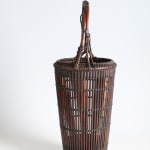Maeda Chikubōsai I
Flower Basket with Natural Bamboo Handle and Antique Arrow Shafts, 1920s-1930s
Bamboo, rattan, lacquer and gold foil
Size 20 x 8 x 7¾ in. (51 x 20 x 19.5 cm)
T-4893
Further images
-
(View a larger image of thumbnail 1
)

-
(View a larger image of thumbnail 2
)

-
(View a larger image of thumbnail 3
)

-
(View a larger image of thumbnail 4
)

-
(View a larger image of thumbnail 5
)

-
(View a larger image of thumbnail 6
)

-
(View a larger image of thumbnail 7
)

-
(View a larger image of thumbnail 8
)

-
(View a larger image of thumbnail 9
)

-
(View a larger image of thumbnail 10
)

-
(View a larger image of thumbnail 11
)

-
(View a larger image of thumbnail 12
)

-
(View a larger image of thumbnail 13
)

-
(View a larger image of thumbnail 14
)

-
(View a larger image of thumbnail 15
)

-
(View a larger image of thumbnail 16
)

-
(View a larger image of thumbnail 17
)

Made using arrow-shaft bamboo, susudake (smoked bamboo), gold foil, lacquer, and rattan, using the techniques of gozame-ami (mat plaiting), magaki-ami (with the verticals secured by small rattan knots), wachigai-ami (interlaced...
Made using arrow-shaft bamboo, susudake (smoked bamboo), gold foil, lacquer, and rattan, using the techniques of gozame-ami (mat plaiting), magaki-ami (with the verticals secured by small rattan knots), wachigai-ami (interlaced circular plaiting) and knotting; natural bamboo handle; striated and lacquered bamboo otoshi (water container).
Signed on the base: Chikubōsai kore o tsukuru (Chikubōsai made this)
Comes with a fitted wood storage box inscribed: Tetsuki kago hana-ire Chikubōsai tsukuru (Handled flower basket made by Chikubōsai) and labeled Maeda Chikubōsai saku yadake hanakago (Arrow-bamboo flower basket made by Maeda Chikubōsai)
Maeda Chikubōsai I worked with Tanabe Chikuunsai I (1877–1937) from about 1912, manufacturing utilitarian baskets for export, but began to exhibit high-quality work from 1926 after a period of intense study of earlier pieces for the sencha style of tea drinking, making several pieces for presentation to the emperor and imperial family. He had access to an abundant supply of susudake (smoked bamboo gathered from above the hearths of old farmhouses), which he used frequently in his work.
This important piece from the latter part of his career exemplifies his mastery of the parallel-line construction technique using antique samurai bamboo arrow shafts still bearing traces of their gold-foil and lacquer decoration, and his skillful incorporation of natural, unsplit bamboo to form a graceful handle that complements the intricacy and precision of the basketry.
For another basket by Chikubōsai I of very similar construction (but a different shape), compare A+C VWG, Baskets: Masterpieces of Japanese Bamboo Art, 1850–2015, n.p. [2017], [Catalogue of the Naej Collection], cat. no. 165; also published in Musée du Quai Branly Jacques Chirac, Fendre L'Air: Art of Bamboo in Japan, exhibition catalogue, 2018, p. 73.
Signed on the base: Chikubōsai kore o tsukuru (Chikubōsai made this)
Comes with a fitted wood storage box inscribed: Tetsuki kago hana-ire Chikubōsai tsukuru (Handled flower basket made by Chikubōsai) and labeled Maeda Chikubōsai saku yadake hanakago (Arrow-bamboo flower basket made by Maeda Chikubōsai)
Maeda Chikubōsai I worked with Tanabe Chikuunsai I (1877–1937) from about 1912, manufacturing utilitarian baskets for export, but began to exhibit high-quality work from 1926 after a period of intense study of earlier pieces for the sencha style of tea drinking, making several pieces for presentation to the emperor and imperial family. He had access to an abundant supply of susudake (smoked bamboo gathered from above the hearths of old farmhouses), which he used frequently in his work.
This important piece from the latter part of his career exemplifies his mastery of the parallel-line construction technique using antique samurai bamboo arrow shafts still bearing traces of their gold-foil and lacquer decoration, and his skillful incorporation of natural, unsplit bamboo to form a graceful handle that complements the intricacy and precision of the basketry.
For another basket by Chikubōsai I of very similar construction (but a different shape), compare A+C VWG, Baskets: Masterpieces of Japanese Bamboo Art, 1850–2015, n.p. [2017], [Catalogue of the Naej Collection], cat. no. 165; also published in Musée du Quai Branly Jacques Chirac, Fendre L'Air: Art of Bamboo in Japan, exhibition catalogue, 2018, p. 73.
















